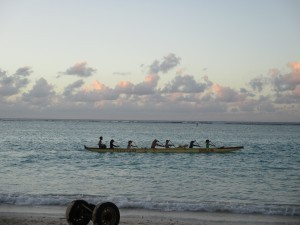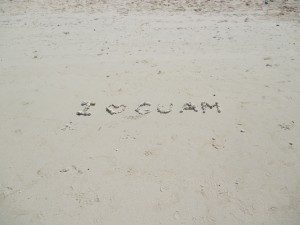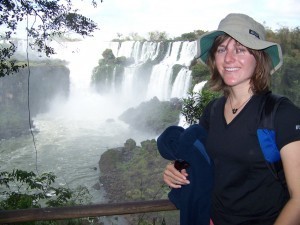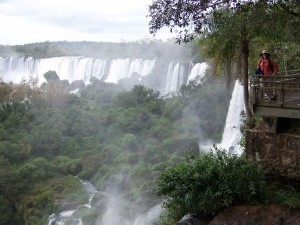Lisa Niver's Blog: We Said Go Travel, page 432
January 14, 2014
Islamabad- The Beautiful City of Pakistan
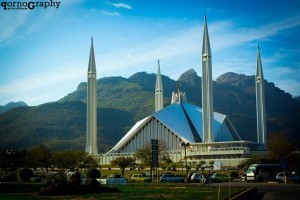
Faisal Mosque, by Qornography
“There!” I exclaimed, firmly holding the steering wheel with one hand while my other hand pointed outside the car’s window. My sister Arooj’s gaze followed the direction and a smile spread on her face. I gradually pulled the car on the road side to have a bird’s eye view of Islamabad. We were on our way up the Margalla hills which is located north of Islamabad and hosts the two popular leisure destinations namely Daman-e-Koh and Peer Sohawa.
On the way further up Arooj noticed a few monkeys peeping from behind the bushes and some frolicking among the Pines and Eucalyptus trees. Luckily we had some fruit to offer which allured a whole bunch of them out from the clusters of Mulberry trees, Peepal and Silver Oaks. These hills are quite popular among hikers, bird watchers, rock climbers and those interested in Paragliding and Hand gliding.
As we reached Damn-e Koh’s view point, the panoramic view of this calm and beautiful capital of Pakistan highlighted Faisal Mosque which is South Asia’s largest mosque .
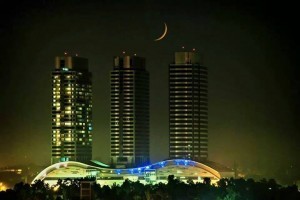
Centaurus
Standing tall and conspicuous among the city’s buildings is the Forty-one storied Centaurus attracts everyone’s attention due to its mega structure comprising of three skyscraper buildings linked by a huge shopping mall.
 This planned city was inhibited in 1964 and is divided into sectors, and sub sectors, each sector catering to the needs of its residents through several markets and parks. The traffic is relatively civilized; roads are smooth making driving less stressful and finding unfamiliar places quite easy. Being home to foreign embassies and large number of foreigners advocates the city’s peacefulness and cleanliness. Islamabad has a high literacy rate of 87 percent and a relatively high cost of living too.
This planned city was inhibited in 1964 and is divided into sectors, and sub sectors, each sector catering to the needs of its residents through several markets and parks. The traffic is relatively civilized; roads are smooth making driving less stressful and finding unfamiliar places quite easy. Being home to foreign embassies and large number of foreigners advocates the city’s peacefulness and cleanliness. Islamabad has a high literacy rate of 87 percent and a relatively high cost of living too.
Food street in Blue area is a hub for foodies. Whether you wish to tantalize your taste buds with traditional Pakistani food or you are in the mood to take them on a journey around the world, food lovers can choose from a wide variety of cuisines available all over the city, operating mostly in houses transformed into restaurants.
Blue area offers a wide variety for shopaholics while Super market and Jinnah Super are quite popular among tourists for handicrafts (the salt lamps, wooden and marble decoration pieces etc) and hand woven Afghani and Persian carpets.
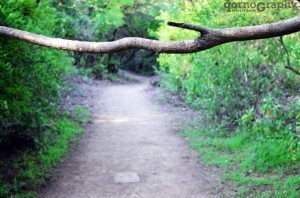
Maragalla hills track 3 by Qornography
Islamabad is a bounty for nature lovers who are looking for some adventure in the stark silence where one hears nothing but the whispers of wind, rustling of leaves and sounds of cracking boughs under one’s boots. The Margalla hills provide a number of Trails for hiking among which Trail 3 is the most popular one.
Pakistan monument and Museum gives a glimpse into our history but Lok Virsa is simply NOT to be missed! This place literally takes you on a detailed tour around Pakistan in the shortest possible time where you can experience the rich multi-ethnic cultures. As the visitors take a walk in its corridors, they come across real life scenarios created in glass show cases along the isle. It is replete with knowledge about the culture and handicrafts of the five provinces.
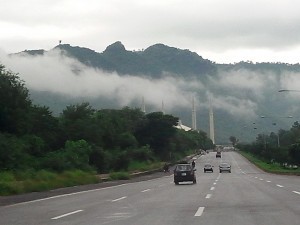
Leisure drive on roads of Islamabad
Living in Islamabad is like dwelling close to nature yet enjoying the hustle and bustle of a cosmopolitan city. Taking a mere walk down the road itself is a pleasurable experience. The air is clean; thanks to millions of trees planted with in the city and massive jungles spread over Margalla hills. Being close to Muree- the most visited hill station of Pakistan; Islamabad serves as a base station for visitors the entire year, especially in seasonal holidays.
Islamabad is not as lively as Lahore but this city has never failed to entertain me. Each time I go on a picnic with kids at a local park, Japanese park, the most beloved F-9 park, or take kids out to the Zoo or Rawal lake, it is always fun! My kids adore “F-1 Trax” where dozens of Disney characters roam around to amuse children.
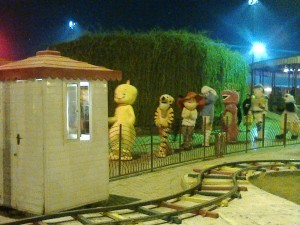
F1 Trax, Lake view park
Floral exhibitions at Rose and Jasmine Garden celebrate the onset of spring every year. People interested in water sports and boating can head straight to Rawal Lake. The city also caters to night life of foreigners. So whether you plan to go out for bowling, Ferrari racing, dinner at a restaurant or watching a play at Islamabad Club, you have quite a hand full of options. But one thing is for sure, nature lovers can never get bored in this beautiful city.
The post Islamabad- The Beautiful City of Pakistan appeared first on We Said Go Travel.
Guam: Flight Paths
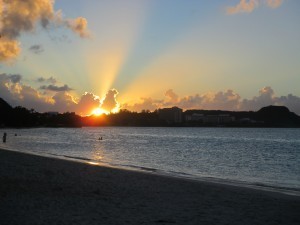 They were stationed in groups along the shores of Tumon. The Japanese. The American military. The Russians.
They were stationed in groups along the shores of Tumon. The Japanese. The American military. The Russians.
The Russians?
This was not 1944. There was no war. Nearly seventy years after the US military liberated Guam from three years of Japanese occupation, here I was. An American-living-in-Japan traveling with the Japanese to vacation in America. There was no shortage of irony here.
The Japanese I had expected – the island was a three-hour jag from Nagoya. Eighty percent of the tourists in Guam were Japanese. The American military was obvious. The navy and the air force had large bases stationed there. Tourist-wise, the Japanese and Koreans were the largest identifiable groups.
The Russians were completely unexpected. I’d lived in Nagoya nearly a year and fell into some sort of mild shock at the sight of hundreds of tall, stealth, light eyed beauties populating the shores of Tumon. The Russians, it turns out, were there on two week holiday. A holiday that began the day after I’d arrived. A holiday Avia Charters had capitalized on by opening a weekly direct service route from Khabarovsk and Vladivostok. A Boeing 737, with capacity for almost 200 passengers.
Tourism is nothing without airlift, Guam Visitors Bureau General Manager Karl Pangelinan was quoted as saying in a local news report. He projects Russian tourist arrivals to double by the end of this year, compared to last year. The day after I arrived, the staff of Guam International Airport welcomed almost two hundred Russian passengers with Chamorro songs and leis as they emerged from customs inspection. Many more were to follow.
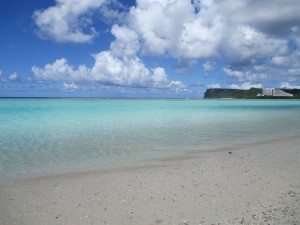 I thought about the influence the airlines have in shaping our travel plans. I’d chosen Guam for the flight length, the ease of accessibility, and the price. An airline, by designating new flight paths and pushing those paths out to adventurous – or simply flexible – travelers, has perhaps more power than any industry to influence our experience of the world. From New York to Iceland, Detroit to Barbados, Toronto to Cuba. An airline wields the power to tell us where – and oftentimes, when – to go.
I thought about the influence the airlines have in shaping our travel plans. I’d chosen Guam for the flight length, the ease of accessibility, and the price. An airline, by designating new flight paths and pushing those paths out to adventurous – or simply flexible – travelers, has perhaps more power than any industry to influence our experience of the world. From New York to Iceland, Detroit to Barbados, Toronto to Cuba. An airline wields the power to tell us where – and oftentimes, when – to go.
The island itself was beautiful. Think a smaller, less crowded Hawaii with smaller waves. The water was a stunning blue, the sand blindingly white. But the biggest lure, for me, was the tranquility of the shores of Tumon. Each day I walked for miles, gazing out along the sea, setting up camp if and when I decided to go for a swim. There was little threat of danger in Tumon, the beach clean, well-patrolled, and only mildly populated. The majority of the tourists being of Asian descent made for tidy, peaceful days. The experience of the island was truly relaxing, a place I would certainly like to return to in the future.
The Japanese. Americans. Thousands of Russians. Who would have thought. And now, as a result of my interactions, I’m starting to think about a trip to southeast Russia.
The post Guam: Flight Paths appeared first on We Said Go Travel.
Milan, Italy: The Freedom of a Million Books
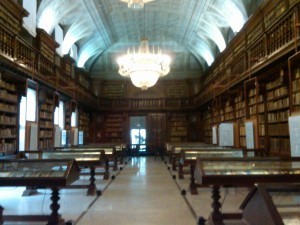 For three months I lived in Milan, Italy, so broke I couldn’t even take the metro across town, let alone spend the afternoons in museums, soaking up the art and freedom of expression. There wasn’t much about my life in Milan that felt very free, I was feeling as if in some sort of personal prison. My only friend, an actress and an artist called me and told me on my last day in Italy, she was taking me to Brera, the artist/university zone right in the middle of Milan. In the midst of the sudden changes and the disappointment of things I had missed or would miss now that I was leaving, with a friend of the most unexpected sort, I found myself brimming with inspiration and freedom. My soul’s cry was met silently in the Braidense National Library, for free.
For three months I lived in Milan, Italy, so broke I couldn’t even take the metro across town, let alone spend the afternoons in museums, soaking up the art and freedom of expression. There wasn’t much about my life in Milan that felt very free, I was feeling as if in some sort of personal prison. My only friend, an actress and an artist called me and told me on my last day in Italy, she was taking me to Brera, the artist/university zone right in the middle of Milan. In the midst of the sudden changes and the disappointment of things I had missed or would miss now that I was leaving, with a friend of the most unexpected sort, I found myself brimming with inspiration and freedom. My soul’s cry was met silently in the Braidense National Library, for free.
That afternoon, I walked into the great, quiet hall as if into a cathedral. The musty scent of old pages and aged leather filled my nose. Thousands upon thousands of books stretched up the walls, their thick, bound leather covers painstakingly adorned with gold leaf and lengthy titles. I walked slowly down the length of the main room, built over 300 years ago and housing nearly a million books. I glanced at the titles of massive volumes, crumbling with age, “The History of Italy”, “The History of Asia”, and a nine volume series on the insects of South America. I marveled at the meticulous detail that was once bestowed upon the skins of literature, science and history. A book was a piece of art from cover to core. It was a prized possession, a source of pride for both author and owner. It was a symbol of knowledge, drive, creation, ambition and freedom. I wanted to reach out and trace my fingers over what were literally the pages of history, to linger on the thoughts of men and women who live immortal through their words.
Enormous crystal chandeliers hung from the center of the room, casting fragmented light across the dark bookshelves and up onto the fresco-painted ceiling. A fifteen foot tall painting of the library’s founder, Empress Maria Theresa of Austria hangs on the back wall, a seven foot round globe of the world sits in a glass cube at her feet.
Downstairs historic sculptures guarded the entrances and busts of renowned artists and philosophers lined the university halls. Librarians spoke in hushed tones with students crouched behind sleek laptops. I wondered what it would be like to study art and philosophy in a place as sacred to art and philosophy as this. Scattered tourists passed the glass displays of Vivaldi’s music, black scratches on yellowed paper. Hundreds of years of history, hundreds of years of philosophy and art, science and literature surrounded me. Hundreds of years of human creativity, knowledge and expression hummed into my being. They were inspired words and notes put to paper, recorded and made fleeting thoughts immortal. It was the ultimate proof of freedom of the mind, of the expression of the soul. And it was proof that I could still feel inspiration of art and literature even if I couldn’t afford to go see Da Vinci’s “The Last Supper” at the museum around the corner.
The heaviness of my broken heart and broken illusions dissipated under the influence of the aroma of the old books, the reverent silence. I smiled as I saw my friend walking just as slowly in her own reverie, under the power the books held. I thought of how had I had all the experience of Italy I wanted or thought I would have had, I would have never dreamed of a friendship in her who appreciated the beauty of an old library. And I wouldn’t have spent my last day in Italy in a dark, musty library, in the presence of thousands upon thousands of books, reminded of the beauty of the freedom and capabilities of the human mind, reminding me to let my soul fly free.
About the Author: Jillian Bright is an avid adventurer, solo traveler and writer from Northern California who lives to see the beauty of this world and write about it all.
Thank you for reading and commenting. Please enter our next Travel Writing competition and tell your story.
The post Milan, Italy: The Freedom of a Million Books appeared first on We Said Go Travel.
January 13, 2014
Tokyo, Japan: Samurais in Sacred Forests
“The Games of the 32nd Olympiad in 2020 are awarded to the city of … Tokyo.”
As the megawatt city of 13 million residents looks to its future along its neon precincts of gadgets, video games and anime, this traveller to Tokyo is hankering for a tree change of the most majestic kind.
I feel like I am riding through one of MC Escher’s impossible realities. As the bus weaves north along the expressway several storeys high between Tokyo’s myriad skyscrapers, the landscape slowly morphs into green grids of paddy fields and hills of bowing bamboo.
After two hours I arrive at the Sacred Forest of Kashima Jingu with its Shinto shrine built in 660BC.
The Sacred Forest is not on the radar of guidebooks, which means I can wander with the locals in its 70 hectares of forests, ponds and deer park, which are scattered with haiku scribed on wooden posts.
My English-speaking guide, Tanaka-san, is brimming with information.
First we cleanse ourselves at the small pavilion called the temizuya, by rinsing our palms and mouths.
We should be entering beneath the majestic 10 metre granite torii, but it collapsed in the Great East Japan Earthquake of 2011. Today, two cedar saplings grow in its place.
Tanaka-san gestures politely as he explains to me the origin of the torii. “The sun goddess hid in a cave and the world became dark. The gods had to coax her out so they set a cockerel on a perch and as it crowed, the sun goddess appeared. Torii actually means bird perch.”
His eyes crinkle and smile as he continues.
“The deity enshrined here is Takemikazuchi, the god of warriors and martial arts. Centuries ago samurais worshipped here to feed on the cosmic powers of the rising sun goddess.”
We enter beneath the lavish vermillion Romon (Tower Gate) that transports us from the everyday world into the enigmatic forest.
“Feel the air change and sense the spiritual energy,” Tanaka-san enthuses.
We stop at the Haiden (hall of worship). Following Tanaka-san’s lead, I show my respect by bowing twice, clapping twice and bowing again.
As we walk the winding gravel paths fringed with ferns and moss-knuckled tree roots that are overhung by cedar, cypress and cherry trees, I look up for the kami (spirits) who live in their branches.
One thing I notice is how the massive tree branches are supported by elaborate bamboo scaffolding. Tanaka-san explains that all trees must be preserved.
It’s a day of celebration. Children are dressed in their finest kimonos as they are purified to gain protection from the deities. They are given fortunes written on paper. Good ones are taken home whereas bad fortunes are tied to a branch and return to the gods.
Kashima means Deer Island. The deer within the forest are said to be descendants of divine messengers. The phrase passing the buck may have originated here. Finding a dying deer in front of your house warranted execution, so you moved it to your neighbour’s door.
In the centre of the Sacred Forest rests the metaphoric fate of Japan. A mythical catfish lives far below. As it thrashes, it bucks the country, causing earthquakes. Its head is pinned down by a keystone, which is held in place by the god, Takemikazuchi. I ask Tanaka-san about the 2011 earthquake. He quips, “Takemikazuchi must have gone for sake!”
Tanaka-san leaves me to wander on my own down the hill to the Sacred Pond. It’s here that I experience my first tea ceremony. To flavour the green tea, I’m given a burnt bamboo stick to stir it with. As I turn the tiny cup to its various positions and slowly sip, it allows me time to take in the nuances of the forest’s quiet beauty.
My walking loop finishes at a small museum where I can almost touch suits of samurai armour. They’re made of lacquered wood and leather; the 1000-year-old saddles are inlaid with mother-of-pearl. There are helmets with facial hair and shoes made of fur and feathers. The sword hilts are bound with leather, sharkskin and twine.
I try and lift the three-metre replica of the 5th century chokuto (straight sword). I can’t imagine how strong the samurais were to swing this hefty weapon about.
In my last minutes of wandering before leaving this sanctuary for the bustle of Tokyo, I’m conscious of the music of the forest. Visiting Kashima Jingu has meant switching off the 21st century. No iPods to intrude, just the nightingale’s song, the cracking of crows and the breath of the cedars.
About the Author: Marian McGuinness is an Australian freelance writer who has travelled beyond the Antarctic Circle to beyond the Arctic Circle. She has explored skull-riddled catacombs and ice cathedrals, French wine caves and opal-bearing mining tunnels. Marian is an award-winning travel writer who uses her travel experiences to write stories for children. Read more about Marian’s adventures.
Thank you for reading and commenting. Please enter our next Travel Writing competition and tell your story.
The post Tokyo, Japan: Samurais in Sacred Forests appeared first on We Said Go Travel.
Limitless Power: Waterfalls and Romance in Argentina
You are 17 years old, and it’s the first time you’ve left the country. You are standing at the base of a 200 foot tall waterfall, staring up. You feel a strong mist caressing your face and arms. You feel the power in the sound, a constant pounding, a never-ending collapse and explosion of energy. You are 17 years old, and you feel nothing.
For a moment you lose yourself. What am I? You cease to think. Standing there, next to this miracle, you become nothing.
The next thought in your head is a big one: I am infinite. I am unlimited. I have the potential to do anything I can dream.
When I was 17 my dad took me on my first big overseas trip to Argentina and Chile. For 6 weeks we traveled by public bus, danced the tango, and hiked up slippery forest trails to sleep in mountain huts. We stayed in hostels, meeting people from all over the world. I convinced him to let us visit Iguazu Falls, the second largest waterfall in the world, which was a 12 hour bus journey away. He finally agreed, as long as I paid for my own transportation. From there, we flew to Bariloche, a lakefront ski town.
We found a great hostel at the top of a 10 story building with breathtaking views of the snowcapped mountains. We were snowed in, and for a week my dad and I became part of the family. I won the poker tournament. We had wine tasting parties. I went out dancing with the other guests, and we shook our booties to Michael Jackson covers. I played a lot of chess and did some knitting, all while talking with other travelers. I even got a guitar lesson from a long-haired, long-bearded Argentinian man with long fingernails trimmed specifically for plucking the steel strings of his guitar he called Melinda.
It was in this town where I had my first kiss. My dad and I went on an evening walk when we discovered a table tennis club. Both of us love to play, so we went inside to check it out. It was there I met Bruno, a handsome young man of about my age. I played against him a few times, losing most of the games. Besides his forehand slice I was particularly impressed by his curly luscious hair, dark skin, and cheeky but confident smile. His poor English was endearing, and we both laughed at my attempts at Spanish.
By the end of the evening, he was infatuated. He told me he thought I was beautiful and that he wanted to see me again. That night it was snowing, and Bruno’s dad gave us a ride back to our hostel in his clunky van. When we parted, Bruno snuck a little kiss on my cheek. I was beaming for the rest of the night.
A few days later my dad and I walk in to the recreation center where we are greeted by the sound of bouncing ping pong balls. Bruno approaches me and asks me for a game. While we are rallying, he is playing very poorly, even though I know from last time that he is a much better player than me. Then he explains.
“Amber, I couldn’t sleep last night.”
“…Why?”
“I just can’t stop thinking about you.”
Meanwhile my dad is over there having an epic rally with Bruno’s potbellied dad.
I think… this is my chance… so I ask Bruno, who is looking at me like a sick puppy dog: “Do you want to take a walk?”
We put on our coats and head outside into the frigid night. I’m feeling a bit nervous about my dad but also know that he is thoroughly distracted. Mostly what I’m nervous about is my first kiss, which I know is about to happen.
I’m facing Bruno, and to my right is the lake framed by snow-capped mountains. The peaks reach their reflections into the frozen lake. It’s a full moon – of course – and the light is shining on Bruno’s face, his eyes locked on mine.
He pulls me close, I close my eyes, and… he starts sucking my face. And not in a good way. It’s like he is trying to stick his entire tongue in my mouth.
Anyway, that is not really the point of the story. Let’s skip that part. I like to remember the romantic setting, the crisp night air, and the moonlight over us.
Moments like this will be with me for the rest of my life. These memories made when I was somewhere completely different, doing something completely new, these are the moments I will remember. This trip with my dad was six years ago, and since then a lot has happened. I graduated from college, and did my own traveling for 28 months.
Now I am home for the first time since leaving in the summer of 2011, home to stay for a while. Not rushing off to travel again, but taking some time at home to write about and process what I have experienced.
Looking back over my old journals, there are hundreds, if not thousands of possible topics that I could choose to write about. These will come flowing out of me in the next days, months, and years. I will continue to travel and be inspired, then it will fall out of me like a torrential waterfall.
I can look at a picture, or even just close my eyes and remember being there, and my soul will travel. And I can do it now. I am standing there, at the base of the waterfall. I can feel the mist on my face. I can hear the constant pounding of water. I am at peace. I am empty.
The post Limitless Power: Waterfalls and Romance in Argentina appeared first on We Said Go Travel.
January 6, 2014
Nigeria: Almajiris Up North
 A traveler to northern Nigeria unavoidably notices them. They live an incredibly exceptional life and survive in the crudest and most unusual manner. Pervading almost every street, they tread smooth roads and coarse terrains scavenging for eatables with which to quench their famished tummy. Their clothes, rather rags, barely cover their sagging, rash-pervaded bodies. With mucous-filled nostrils, they anxiously peruse garbage for booties. They beg for money. They feed on remnants. With germ-ridden bowls and hands stretched out, they rush at passers-by on streets and motorists in traffic, known and unknown, for whatever they could possibly obtain. Anything, any amount! These they did day in, day out. The almajiris do just anything to survive!
A traveler to northern Nigeria unavoidably notices them. They live an incredibly exceptional life and survive in the crudest and most unusual manner. Pervading almost every street, they tread smooth roads and coarse terrains scavenging for eatables with which to quench their famished tummy. Their clothes, rather rags, barely cover their sagging, rash-pervaded bodies. With mucous-filled nostrils, they anxiously peruse garbage for booties. They beg for money. They feed on remnants. With germ-ridden bowls and hands stretched out, they rush at passers-by on streets and motorists in traffic, known and unknown, for whatever they could possibly obtain. Anything, any amount! These they did day in, day out. The almajiris do just anything to survive!
I felt this unimaginable gratitude not because of a prosperous occurrence in my life but by merely reflecting on the abject conditions they lived in. I was awed not by any glamor in their lives but by their crude and rugged way of survival.
Until this sojourn, I could only imagine people living such anomalous lives. Here however, I see the almajiri who would not complain that a well-prepared meal is not the choice repast but would hastily jump at just anything that can pass through the esophagus. Anything goes! For them, choice is an opulence they could ill afford.
These children, the almajiris are child-beggars ranging between ages four and twelve; and by far, they form the most worrisome scenes in my entire odyssey up north – an odyssey which began at Agege Park in Lagos where my dad and I boarded a luxurious bus.
At stops after the park, ‘attachment’ passengers joined in till the whole bus became crowded and stuffy. People everywhere! But it seems good business for both the motorists and the attachments. The motorists thereby increased their earnings and the attachments travel at a reduced fare though in harsh conditions.
I constantly felt heavy pressure on my right shoulder. It was the man standing beside me leaning intensely on me as he either drifts off or loses balance. He was just one of the many attachments who stood throughout the journey. Some managed to sit on the bare floor. Others, not so lucky, ‘hung’ onto iron bars for the about 18-hours journey. It dawned on me that my seat was a luxury.
This and every bit of my journey up north infused me with a unique splendor of appreciation for the many blessings we habitually take for granted.
As the bus covered distances, my sight caught hold of the North’s agricultural endowment – vast land and a sizable farming population providing the great chunk of the country’s everyday nourishment. Just as I gaze in outlandish astonishment, murmurs roar from behind; western women complaining that the north offers nothing to the federation. This indeed is a country sharply divided along many lines. As I pondered about Nigeria’s continued existence, I helplessly failed to subscribe to their postulations, for before me lay North’s contribution to national wealth. While the western and eastern regions boast of commerce and oil, the north can equally boast of agriculture!
Kano was the last stop. The remaining passengers alighted. Journeying to my dad’s lodge at ‘Sabon-Geri’, a settlement for outlanders at the heart of Katsina state, I was immediately amused by the infrastructure. Though it wasn’t exceptional, it ridiculed my preconception. Like many, I had thought the north to be a jungle – more like the state of nature described by Hobbes. So, I couldn’t conceal an illuminated expression of wonder seeing many good roads and a relatively stable electricity supply.
Interacting with the natives was pleasurable. They were people with every feature a human possesses. By their uncomplicated lifestyle, they taught me to value the inherent beauty in diversity and variation. In Lagos where I grew up, life can be atrocious like when you are stuck in traffic jam; when you cannot meet your bills despite working round the clock; and when times are perilous. Of course, Lagos city has its alluring charms too. But life here was basic, simple, devoid of complexities, and so much to look forward to.
Touring some northern states in Nigeria including Katsina and Zamfara for about three weeks, what emerged were matchless feelings of awe for the bizarre daily-life of the almajiris and the risky ventures of the attachments; and gratitude for blessings commonly belittled together with a penchant for the adorable pulchritude which overwhelms the region.
That’s the anecdote of my sojourn up north; a place that inspires awe, gratitude and a reinforced proclivity for travelling.
About the Author: Abdullateef Abdul is an undergraduate law student from the University of Lagos, a writer, editor, researcher and a progress-enthusiast. He lives in the Lagos coastal city. For more information, visit his Facebook page.
Thank you for reading and commenting. Please enter our next Travel Writing competition and tell your story.
The post Nigeria: Almajiris Up North appeared first on We Said Go Travel.
A Love Letter to Paris
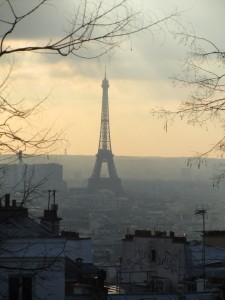 Paris is like a woman of a certain age, wholly unconcerned by the need to please and with every night we spend chasing the final train she seems to say “this is who I am, take me or leave me.” I choose to do the former.
Paris is like a woman of a certain age, wholly unconcerned by the need to please and with every night we spend chasing the final train she seems to say “this is who I am, take me or leave me.” I choose to do the former.
I escape from my apartment unto our tiny alley of a street, Rue de Fontaigne du Temple. Although it’s winter the city is cold and grey it still looks like something out of a dream. Today, like most other Saturdays I have no plan but to wander aimlessly around the city. I stroll down Rue du Temple window shopping and enjoying the silence of the street, stopping only to check for new wares at a vintage store. My quiet stroll is broken when I get to the crowded Rue de Rivoli.
As I let myself be carried down the stream of tourists on Rivoli I wonder if this isn’t truly the most beautiful city in the world. Where else would I not be bothered by the abrupt stops of the Italian family of six in front of me who, in trying to control two toddlers leave me no room to pass? But beauty has its limits as does my patience. I break away from the crowd, unto a small street, soon finding myself on rue Saint Honore. My roommate would mostly likely scoff at what is turning out to be a day spent in the most cliched corners of Paris.
It’s a little past lunch time and I eschew the appealing Parisian cafes for a tiny Chinese restaurant. A choice I blame on four years spent in New York City where I came to know Chinese takeout as comfort food. I’m the only customer and have the full attention of the server. After gorging myself on greasy noodles and shrimp, I’m presented with something that looks like a puzzle. He explains to me that it’s a timed game and points at a signed drawing on the wall, which I come to learn is the answer key of the fastest patron ever, a young Polish man. I’m not certain that I understand but I go along with it.
After about twenty minutes I somehow complete the puzzle of animal faces, still not sure of the purpose of the game. The server cheers, hands me two postcards from China and tells me, mostly gesturing, a little about his homeland. I leave several minutes later wondering what brought him here, a question I ask of non Parisian I meet. Perhaps I’m still trying to figure out what called me to this city.
I think of Fred, the most peculiar of the exchange students and the only person who seems to have a real reason for being here. Fred is a poet and spends much of his time sitting alone in cafes looking purposefully pensive. He wears a uniform consisting of a striped nautical t-shirt, jeans, an oversize black trench coat and a black beret and always carries a small black moleskin and a pen. When he does engage with us, he speaks of Hemingway and Cafe de Flore, and muses of how much the city inspires him. He will finish a book of poems in these six months, he says.
I make my way to Jardin du Tuileries as it’s already too late to save the day from becoming a cliched afternoon in Paris. I sit on a cold metal chair, take my journal from my bag and begin what has become my Saturday ritual. As I’m about to put pen to paper I pause for a moment and laugh wondering if I’m turning into Fred. Has Paris become my muse? Then I recall the many late nights since my teen years spent scribbling on loose sheets of paper in the dark. The difference with Paris is the words don’t only haunt me after dark. It happens in the quiet little streets, crowded cafes or on a bench near the busy Eiffel Tower. Perhaps it’s because Paris feels like something of a dream, it’s easy for the mind to be as quiet as midnight, for it to find the kind of peace needed to create. Some days I think it’s the city showing me my reason for being here, as if she is giving me permission to write.
About the Author: Kristie Gonsalves is a freelance writer living one foot in Miami and the other in the Caribbean. Find more on her blog and is also working on a Caribbean style and culture publication.
Thank you for reading and commenting. Please enter our next Travel Writing competition and tell your story.
The post A Love Letter to Paris appeared first on We Said Go Travel.
Travel Writing Contest: First Prize: $1,000usd
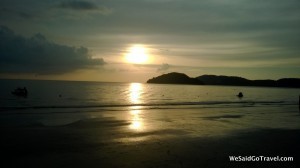
Cenang Beach, Langkawi, Malaysia 2013
INSPIRATION TRAVEL WRITING CONTEST
$1,750usd in CASH PRIZE
Free Entry
Dates: January 2, 2014 – February 14, 2014 at midnight PST.
We are looking for an article about a place that inspires you to spend your time with no regrets. In Arnold Bennett’s book, How to Live on 24 Hours a Day, he writes about how time is the ideal democracy. “No one can take [time] from you. It is unstealable. And no one receives either more or less than you receive.” Every morning we have a new day, as he says, “The supply of time is truly a daily miracle.” Where and how do you wish to spend your time?
THEME: Inspiration: A place that inspires you to spend your time wisely with no regrets.
PRIZES:
1st Prize - $1,000 usd cash
2nd Prize - $500 usd cash
3rd Prize - $250 usd cash
Winners will be selected by our judges, Richard Bangs, Amy Friedman and the We Said Go Travel Team. Cash prizes will be paid through PayPal in United States Dollars. All winning entries will be promoted on We Said Go Travel.
RULES: Publication is dependent on proper use of English language and grammar, appropriateness of theme topic, and being family friendly (G rated). If your post is written in a language other than English, please also send an English translation. Travelers of all ages and from all countries are encouraged to participate. Each individual may send up to 5 entries that are 500-800 words with 1 photo. Your article must be an original and previously unpublished piece. All posts, which meet the requirements, will appear on WeSaidGoTravel.com.
DEADLINE: Enter by midnight PST on February 14, 2014.
JUDGING: Richard Bangs, Amy Friedman and the We Said Go Travel Team
TO ENTER: Click here!

Lisa and George, We Said Go Travel, New Year’s Eve, Langkawi, Malaysia
Richard Bangs, the father of modern adventure travel, is a pioneer in travel that makes a difference, travel with a purpose. He has spent 30 years as an explorer and communicator, and along the way led first descents of 35 rivers around the globe, he is currently producing and hosting the new PBS series, Richard Bangs: Adventure Without End
Amy Friedman, an award-winning author, has published three memoirs, several children’s books and audiobooks, and thousands of essays, stories, and articles. She works as an editor and ghostwriter teaches memoir and personal essay in southern California. Amy’s recent books: Desperado’s Wife: A Memoir , and her co-authored memoir with Anne Willan, One Souffle at a Time.
, and her co-authored memoir with Anne Willan, One Souffle at a Time.
Thank you for your participation in creating a growing global community of engaged travelers and concerned citizens. Writers of all ages and from all countries are encouraged to enter and share stories from any part of our planet.
Other Contests, Courses and Books about Travel Writing
The post Travel Writing Contest: First Prize: $1,000usd appeared first on We Said Go Travel.
Captivated In Bogota, Colombia
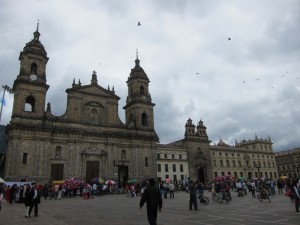 One of the byproducts of not planning a trip is that expectations drop to ambiguous media tidbits and scattered commentary from friends or fellow travelers, as was the case of Bogota, Colombia. It was the last stop of 3 months of travels through Central and South America, and was a close contender with Peru, Chile and Ecuador. After much vacillating, Colombia won out, partially due to its dangerous reputation that appealed to my illogical sense of adventure despite concerns of being a woman travelling alone.
One of the byproducts of not planning a trip is that expectations drop to ambiguous media tidbits and scattered commentary from friends or fellow travelers, as was the case of Bogota, Colombia. It was the last stop of 3 months of travels through Central and South America, and was a close contender with Peru, Chile and Ecuador. After much vacillating, Colombia won out, partially due to its dangerous reputation that appealed to my illogical sense of adventure despite concerns of being a woman travelling alone.
The US embassy websites did nothing to assuage my concerns but further piqued my interest. While securing travelers insurance in the U.S., a kind woman on the phone explained my benefits should there be an emergency abroad. I perversely, and nervously, wanted to know, “Does it cover kidnappings in Colombia?”
I had set out on my travels alone but, because of the many friends and family at my destinations along the way, I rarely felt alone. I had the best of both worlds at my fingertips until Colombia.
My arrival into Bogota was irrevocably alone and I found myself in an unfamiliar place which I knew little about except for echoes of warnings and danger orbiting my mind. Pensive rain greeted me upon arrival creating the perfect backdrop to view the graffiti art scattered along the highways and roads at high speeds, at once primal, dark and painfully honest yet surging with life and hope around its rough, uncompromising edges. It was my first impression of Colombia, and after seeing the graffiti art in Rio de Janeiro and Buenos Aires, I realized it had perhaps more to say about the landscape, the people, the politics and the struggles than a brochure or history lesson could adequately capture.
As darkness descended, the rain downgraded to more of a drizzle but the night sky was amplified by lightning flashes. From my terrace I watched the subdued spectacle, captivated by the energy and light, when I heard the sound of loud music from quite some distance away. The beat of the music consumed me and I was overcome by the urge to dance on the rooftop terrace alone. In that moment I realized that this unfamiliar place had been emanating a euphoric energy, submissive and simultaneously inspired by more sinister energies; the perfect blend of life and death; of happiness and sorrow.
Setting out on foot through the streets of Bogota, I was struck by the lack of Americans and postcards for sale. It gave the sense of being not just a tourist, but a stranger in another land. A taxi driver understood my broken Spanish enough to take me to La Candelaria, the historic part of Bogota. There was a moment of panic when I seemed to be taken in the opposite direction of my desired destination, but there was enough communication to gather that I would not be kidnapped via taxi. When he began taking turns at such high speeds that the tires squealed, I became elated and had to suppress my laughter.
The world suddenly became more vivid and everything came into focus.
I was dropped off where La Candelaria’s heartbeat seemed to originate, brimming with people wandering amidst the venerable structures. I made my way through the groups, peering into shops and trying to absorb every architectural detail without looking like the tourist or stranger I was. A block away was a courtyard, with a view of an imposing cathedral and other buildings. I walked in the erratic ways of a stranger alone in an unfamiliar place, creating unconscious circles for many minutes watching the people sitting on the cathedral steps, the children laughing and playing, the families and groups of people milling about the vendors, street artists, and performers. I ended up near the center of the courtyard where hundreds of birds roamed about when suddenly, one bird took flight. It was followed by another and yet another, then a seeming hundred or more. I was captivated and tried to follow them with my eyes, the spiraling pattern they flew in, circumnavigating the courtyard lifting up high then swirling down. My body followed of its own accord and I found myself staggering and almost losing my balance in unabashed wide-mouthed awe. It could have been a mundane event were it not for the sheer number of birds expressing a version of life in movement and flight with the stately, stagnant cathedral in the background as well as my own state of mind. Suddenly being a stranger and alone was nothing more than the flight of winged birds and just as breathtakingly beautiful. I was a stranger in an exquisitely beautiful, purportedly dangerous land.
I was alive in a moment of flight, thankful for every rapturous moment I was alone.
About the Author: Naomi Fino currently resides in California, loves to travel, write, sew and design, fire dance, and has a healthy appetite for a good “Adventura”. Visit her new blog.
The post Captivated In Bogota, Colombia appeared first on We Said Go Travel.
January 5, 2014
Why I Am Thankful for Andorra
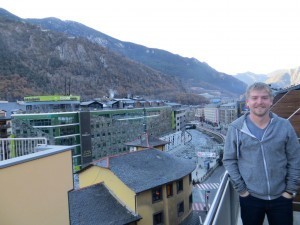 “We are going to die. We are going to slip off the road and die,” was the only thing that my friend Leland could say as he sat in the passenger seat of our rental car. Leland and I were traveling to Paris after several days in Barcelona. We decided that we would drive to Andorra, a tiny principality tucked in between the borders of France and Spain and smack dab in the middle of the Pyrenees mountain range. The plan was to stay the night and then continue on to Paris in the morning. I am grateful we did because the next morning we ended up sliding down a frozen mountain road in our rented Audi station wagon.
“We are going to die. We are going to slip off the road and die,” was the only thing that my friend Leland could say as he sat in the passenger seat of our rental car. Leland and I were traveling to Paris after several days in Barcelona. We decided that we would drive to Andorra, a tiny principality tucked in between the borders of France and Spain and smack dab in the middle of the Pyrenees mountain range. The plan was to stay the night and then continue on to Paris in the morning. I am grateful we did because the next morning we ended up sliding down a frozen mountain road in our rented Audi station wagon.
“We have limited time, we’ll see more of the country that way, and we can stop wherever we want if we decide to make a few side trips.” It is not the most economical way of seeing Europe, but Leland and I were only careening around the EU for two weeks and we wanted to squeeze in as many sights as possible. We agreed driving was the way to go.
We headed towards Andorra la Vella after getting a late start leaving Barcelona. Thankful to get a few hours rest after a jam packed beginning to the trip. For those unfamiliar with Andorra, I was too and completely unaware it existed until we needed a place to stay. The capital or only city in the principality is Andorra la Vella. Andorra is known primarily as a ski resort town, which was confusing because we had not seen any snow at that point, but we were surrounded by people waiting to get on the slopes the next day.
The morning sun greets us through the shutters, we grab a quick breakfast, and hop in the car to make our way to Paris. The road climbs higher and we catch our first glimpse of snow lining the street. A set of flashing signs alert us that we might need chains. We make a left and before we knew it we were halfway up a frozen, snow drift covered road. I punch the accelerator to grab some traction but our tires spin helplessly and we start sliding backwards down the road. Most other travelers had gotten the idea much earlier so we were not in danger of hitting any other cars. We were in danger of hitting the snow bank at the bottom of the hill and thankfully skid to a stop just before nose diving into the ice covered guard rail.
Our Audi crawls back to iceless pavement and a roundabout brings us to a tunnel undercutting one of the higher peaks. It seems logical that we might be able to skirt the chains requirement by avoiding going over the peak. The artificial light from the tunnel ends and our station wagon is at a fork in the road. Turn right for the ski resorts. Left to Paris and down a switch backed, frozen stretch of service road through the Pyrenees in the middle of winter. Right it is.
The car starts gently sliding and I start giggling like a little school girl I am so nervous. Leland is chain smoking hand rolled cigarettes in assembly line fashion. He would roll a cigarette, start furiously puffing on it, and then would immediately begin rolling another to keep himself distracted from the impending doom facing us as we slid around the guardrail-less hairpin turns. It took us over an hour to ride the brakes down the mountain switchbacks. It might have been years as we traveled what couldn’t have been more than 2 miles.
Obviously, we survived. It was not as obvious at the time that would be the outcome and as soon as our wheels hit solid, dry pavement we stopped the car and started dancing and screaming, “I love life!” The Pyrenees had captured our respect and we were awestruck by their bleak and looming snowcapped peaks. Terrified as we were, standing at the bottom of the range gave new cause for our jaws to drop as their initially estimated size did no justice to their grandeur or the majesty we felt staring back at them from our much lower, safer perspective.
I am grateful to be alive and, strangely, I am grateful for Andorra la Vella. We needed a place to stay after driving late into the night and Andorra invited us to rest for a few extra hours at exactly the right time. I am grateful because without Andorra la Vella, Leland and I would be stuck on the side of a mountain in the middle of the night. What’s worse, we might not have made it to where the ice met the pavement.
About the Author: Casey Keenan lives in San Francisco, enjoys good beer, and is looking to buy a fish tank in the near future. He hopes that the fish aren’t too much of a commitment so he can continue to travel as much as possible.
Thank you for reading and commenting. Please enter our next Travel Writing competition and tell your story.
The post Why I Am Thankful for Andorra appeared first on We Said Go Travel.
We Said Go Travel
We Said Go Travel is a global community of over sixteen hundred writers with articles from every continent.
Stories are shared with photos and video from a perspective of the transformative power of travel. We Said Go Travel has hosted live and online events as well as travel writing contests around the world. ...more
- Lisa Niver's profile
- 57 followers


